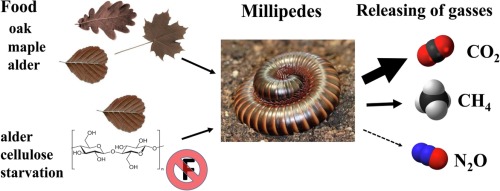Soil Biology and Biochemistry ( IF 9.7 ) Pub Date : 2020-02-28 , DOI: 10.1016/j.soilbio.2020.107765 Vladimír Šustr , Miloslav Šimek , Lucie Faktorová , Jana Macková , Karel Tajovský

|
The release of greenhouse gases from millipede digestive tracts warrants study because of its potential effect on climate change and also as an indicator of microbial processes that transform organic matter during passage through the gut of these animals. Gas chromatography was used to quantify the release of methane (CH4), carbon dioxide (CO2), and nitrous oxide (N2O) from living millipedes in laboratory conditions. The effect of four food types (leaf litter of alder, oak, and maple, and rotten wood) on the release of CH4, CO2, and N2O by 12 species was also assessed. In addition, two julid species were fed pure cellulose to test the ability of these millipedes to obtain energy from cellulose and to determine the effect of this diet on gas production.
All of the tested millipede species produced CO2 and some produced CH4. Stable and substantial CH4 emission was restricted to the large millipedes in the tropical orders Spirobolida and Spirostreptida. This asymmetrical phylogenetic distribution of CH4 production may be related to body size and the presence of gut commensals, but these factors may influence each other and depend upon geographic distribution of species. The quality of the food and feeding regime can also affect CH4 production in that CH4 release was significantly higher when millipedes were fed alder leaf litter rather than oak or maple leaf litter. CO2 production from millipedes mainly reflected the metabolic response of the animals. Traces of N2O were only occasionally emitted by millipedes; this release evidently depends on the N content in the food and seems to be restricted to members of the Glomeridae family. Based on gas production, the tested species of millipedes were unable to obtain their energy needs from a diet of pure cellulose.
中文翻译:

与食物,体重和其他因素有关,千足虫释放的温室气体
从千足动物的消化道释放温室气体值得研究,因为它对气候变化具有潜在影响,并且还可以作为微生物通过这些动物的肠道过程中转化有机物质的微生物过程的指标。在实验室条件下,气相色谱法用于定量从活的千足虫中释放出甲烷(CH 4),二氧化碳(CO 2)和一氧化二氮(N 2 O)。四种食物类型(al木,橡树和枫树的叶子凋落物和腐烂的木材)对CH 4,CO 2和N 2释放的影响还评估了12种物种的O。此外,还给两种茄科动物提供纯纤维素,以测试这些千足虫从纤维素中获取能量的能力,并确定这种饮食对产气的影响。
所有测试的千足虫物种均产生CO 2,有些产生CH 4。稳定和大量的CH 4排放被限制在热带螺旋藻和螺旋链霉菌中的大千足虫。CH 4产生的这种不对称的系统发育分布可能与人体大小和肠道共生关系有关,但是这些因素可能彼此影响,并取决于物种的地理分布。食物和进食方式的质量也会影响CH 4的产生,因为当千足虫饲喂al木落叶而不是橡树或枫叶落叶时,CH 4的释放明显更高。一氧化碳2千足虫的生产主要反映了动物的代谢反应。痕量的N 2 O只是偶尔由千足虫发出。这种释放显然取决于食物中的N含量,并且似乎仅限于Glomeridae家族的成员。根据产气量,被测试的千足虫物种无法从纯纤维素饮食中获得能量需求。



























 京公网安备 11010802027423号
京公网安备 11010802027423号